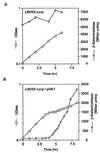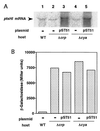cAMP receptor protein-cAMP plays a crucial role in glucose-lactose diauxie by activating the major glucose transporter gene in Escherichia coli
- PMID: 9371775
- PMCID: PMC24238
- DOI: 10.1073/pnas.94.24.12914
cAMP receptor protein-cAMP plays a crucial role in glucose-lactose diauxie by activating the major glucose transporter gene in Escherichia coli
Abstract
The inhibition of beta-galactosidase expression in a medium containing both glucose and lactose is a typical example of the glucose effect in Escherichia coli. We studied the glucose effect in the lacL8UV5 promoter mutant, which is independent of cAMP and cAMP receptor protein (CRP). A strong inhibition of beta-galactosidase expression by glucose and a diauxic growth were observed when the lacL8UV5 cells were grown on a glucose-lactose medium. The addition of isopropyl beta-D-thiogalactoside to the culture medium eliminated the glucose effect. Disruption of the crr gene or overproduction of LacY also eliminated the glucose effect. These results are fully consistent with our previous finding that the glucose effect in wild-type cells growing in a glucose-lactose medium is not due to the reduction of CRP-cAMP levels but is due to the inducer exclusion. We found that the glucose effect in the lacL8UV5 cells was no longer observed when either the crp or the cya gene was disrupted. Evidence suggested that CRP-cAMP may not enhance directly the lac repressor action in vivo. Northern blot analysis revealed that the mRNA for ptsG, a major glucose transporter gene, was markedly reduced in a delta crp or delta cya background. The constitutive expression of the ptsG gene by the introduction of a multicopy plasmid restored the glucose effect in delta cya or delta crp cells. We conclude that CRP-cAMP plays a crucial role in inducer exclusion, which is responsible for the glucose-lactose diauxie, by activating the expression of the ptsG gene.
Figures






Similar articles
-
Mechanism responsible for glucose-lactose diauxie in Escherichia coli: challenge to the cAMP model.Genes Cells. 1996 Mar;1(3):293-301. doi: 10.1046/j.1365-2443.1996.24025.x. Genes Cells. 1996. PMID: 9133663
-
A global repressor (Mlc) is involved in glucose induction of the ptsG gene encoding major glucose transporter in Escherichia coli.Mol Microbiol. 1998 Sep;29(6):1509-19. doi: 10.1046/j.1365-2958.1998.01035.x. Mol Microbiol. 1998. PMID: 9781886
-
CRP down-regulates adenylate cyclase activity by reducing the level of phosphorylated IIA(Glc), the glucose-specific phosphotransferase protein, in Escherichia coli.Mol Gen Genet. 1998 Aug;259(3):317-26. doi: 10.1007/s004380050818. Mol Gen Genet. 1998. PMID: 9749675
-
The cyclic AMP-cyclic AMP receptor protein complex regulates activity of the traJ promoter of the Escherichia coli conjugative plasmid pRK100.J Bacteriol. 2003 Mar;185(5):1616-23. doi: 10.1128/JB.185.5.1616-1623.2003. J Bacteriol. 2003. PMID: 12591879 Free PMC article.
-
Syn, anti, and finally both conformations of cyclic AMP are involved in the CRP-dependent transcription initiation mechanism in E. coli lac operon.Cell Biochem Funct. 2008 Jun;26(4):399-405. doi: 10.1002/cbf.1462. Cell Biochem Funct. 2008. PMID: 18338329 Review.
Cited by
-
Quantitative effect and regulatory function of cyclic adenosine 5'-phosphate in Escherichia coli.J Biosci. 2009 Sep;34(3):445-63. doi: 10.1007/s12038-009-0051-1. J Biosci. 2009. PMID: 19805906
-
Alkaline pH Is a signal for optimal production and secretion of the heat labile toxin, LT in enterotoxigenic Escherichia coli (ETEC).PLoS One. 2013 Sep 18;8(9):e74069. doi: 10.1371/journal.pone.0074069. eCollection 2013. PLoS One. 2013. PMID: 24058516 Free PMC article.
-
Discriminating tastes: physiological contributions of the Hfq-binding small RNA Spot 42 to catabolite repression.RNA Biol. 2011 Sep-Oct;8(5):766-70. doi: 10.4161/rna.8.5.16024. Epub 2011 Jul 26. RNA Biol. 2011. PMID: 21788732 Free PMC article.
-
Sinorhizobium meliloti mutants lacking phosphotransferase system enzyme HPr or EIIA are altered in diverse processes, including carbon metabolism, cobalt requirements, and succinoglycan production.J Bacteriol. 2008 Apr;190(8):2947-56. doi: 10.1128/JB.01917-07. Epub 2008 Feb 15. J Bacteriol. 2008. PMID: 18281401 Free PMC article.
-
The acetate switch.Microbiol Mol Biol Rev. 2005 Mar;69(1):12-50. doi: 10.1128/MMBR.69.1.12-50.2005. Microbiol Mol Biol Rev. 2005. PMID: 15755952 Free PMC article. Review.
References
-
- Magasanik B. In: The Lactose Operon. Beckwith J, Zipser D, editors. Plainview, NY: Cold Spring Harbor Lab. Press; 1970. pp. 189–220.
-
- Ullmann A, Danchin A. Adv Cyclic Nucleotide Res. 1983;15:1–53.
-
- Meadow N D, Fox D K, Roseman S. Annu Rev Biochem. 1990;59:497–542. - PubMed
-
- Saier M L, Jr, Ramseier T M, Reizer J. In: Escherichia coli and Salmonella tryhimurium: Cellular and Molecular Biology. Neidhardt F C, Curtis R III, Ingraham J L, Lin E C C, Low K, et al., editors. Washington, DC: Am. Soc. Microbiol.; 1995. pp. 1325–1343.
Publication types
MeSH terms
Substances
LinkOut - more resources
Full Text Sources
Other Literature Sources
Molecular Biology Databases
Research Materials
Miscellaneous

